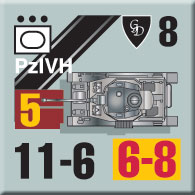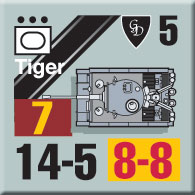Grossdeutschland 1944:
Scenario Preview, Part Two
by Mike Bennighof, Ph.D.
April 2025
 I suppose there’s a thrill to finding out obscure bits of military history, like the table of organization for the 1378th People’s Mess Kit Repair Battalion. But if you can’t use that information as a means to tell your story, then you’re not doing much better than that dude who researches his “historical” games by cribbing from other peoples’ computer games. I suppose there’s a thrill to finding out obscure bits of military history, like the table of organization for the 1378th People’s Mess Kit Repair Battalion. But if you can’t use that information as a means to tell your story, then you’re not doing much better than that dude who researches his “historical” games by cribbing from other peoples’ computer games.
So anyway, I wanted to turn the stuff I found out about the August 1944 Soviet Kishinev Operation into a story. This time I actually didn’t find out very much of it on my own, I read a lot of what other people found out (’cause you know, reading 25 books makes you an expert). But I thought it could be put together to tell a good story in Panzer Grenadier format, and that’s the conceit of the Panzer Grenadier: Grossdeutschland 1944 expansion book. Let’s resume our look at its scenarios with Chapter Two, which concerns the Soviet 46th Army’s assault.
Scenario Seven
At the Seam
20 August 1944
 Soviet scouting and intelligence operations had identified most of the boundaries between defending Axis divisions along the Dnestr River line. The Soviets had already seized bridgeheads over the big river, forcing the Axis to defend further back in the wooded hills just to the west. Soviet scouting and intelligence operations had identified most of the boundaries between defending Axis divisions along the Dnestr River line. The Soviets had already seized bridgeheads over the big river, forcing the Axis to defend further back in the wooded hills just to the west.
Conclusion
The Soviets battered 4th Mountain Division, and shoved it back off its hilltop positions. Twenty-First Infantry Division remained intact but pulled back to cover its now-open left flank. The Soviet 46th Army had achieved its first-day objectives, which meant that 4th Mechanized Corps could soon be introduced to widen and deepen the breach in the Axis lines.
Notes
This is a set-piece Soviet attack against a fortified Romanian line. The Romanians have entrenchments and minefields to help them hold, but Soviet firepower is just overwhelming. The bar of victory is set pretty high for the Soviets, but they have plenty of airplanes, artillery and Guards infantry to make it happen.
Scenario Eight
Shadow Division
20 August 1944
 Fourth Mountain Division had been one of the Royal Romanian Army’s crack formations when the war with the Soviet Union began in 1941. In early 1943 it suffered heavy casualties in the Kuban campaign, losing two-thirds of its personnel. To bring it back to strength it absorbed the 24th Infantry Division, an ad hoc formation of Stalingrad survivors and conscripted criminals, and fresh drafts of newly-inducted young recruits. When faced with a full-scale prepared assault it fell back in haste, with the Soviets in hot pursuit. Fourth Mountain Division had been one of the Royal Romanian Army’s crack formations when the war with the Soviet Union began in 1941. In early 1943 it suffered heavy casualties in the Kuban campaign, losing two-thirds of its personnel. To bring it back to strength it absorbed the 24th Infantry Division, an ad hoc formation of Stalingrad survivors and conscripted criminals, and fresh drafts of newly-inducted young recruits. When faced with a full-scale prepared assault it fell back in haste, with the Soviets in hot pursuit.
Conclusion
The battered Romanian mountain division had never recovered from the shock of the initial bombardment and assault. Throughout the day it continued to melt away. Some of its troops ended up fighting alongside other German or Romanian formations, but by the following morning the division had effectively ceased to exist.
Notes
This is a race game - both sides are trying to rush off the southern edge of the map. Except that they get to shoot at each other, which would kind of be cheating were it a real race. The Romanians win by running away; the Soviets win by catching them, stomping them and running on past them.
Scenario Nine
Haunted Forest
20 August 1944
 While 4th Mountain Division to its left fell apart, the 21st Infantry withdrew into the nearby forest in good order. A second defensive line had been prepared there, and the division was at full strength and considered one of the best-trained formations in the Armata Romana. After a short, sharp bombardment the Soviet Guards renewed their attack. While 4th Mountain Division to its left fell apart, the 21st Infantry withdrew into the nearby forest in good order. A second defensive line had been prepared there, and the division was at full strength and considered one of the best-trained formations in the Armata Romana. After a short, sharp bombardment the Soviet Guards renewed their attack.
Conclusion
While the Romanians had occupied their second line of defenses without incident, the Soviets bundled them out of this line, too. Twenty-first Infantry Division had suffered heavy losses in front of Odessa in 1941 and remained in its home garrison for the next three years. It went to war at full strength, with a cadre of experienced officers and men and weapons as modern as any in the Romanian arsenal. On this first day of the offensive it maintained good order, but its staff worried over their now-open left flank. The Soviet 1201st Self-Propelled Artillery Regiment actually operated T-34 tanks as shown here.
Notes
The Romanians should be in good shape to hold this line, but maybe not against an enemy with these numbers plus tanks and artillery. This is one battle where the Soviets performed far better than the balance of forces and terrain would suggest, so it’s a chance for the Romanians to score a rare unassisted win over the Red Army.
Scenario Ten
On to Tarutyne
21 August 1944
With the initial Axis defenses shattered, the Soviet 46th Army now committed its attached 4th Guards Mechanized Corps. The German panzer divisions that had formed the operational reserve to counter such a move had been sent northward to support the collapsing German Army Group Center. Little stood between the Soviet tankers and their first-day objective of Tarutyne some 80 kilometers behind the Axis lines, other than the Romanian division defeated on the previous day.
Conclusion
The Romanian division, already shaken by the previous day’s combat, could do little to stop the rampaging Soviet tanks. The Guards stormed through their positions, having been slowed only a little by the attempted defense, and surged on toward their objective. Twenty-First Infantry Division broke up following the breakthrough and its troops streamed westward in small groups.
Notes
And now the Romanians have to face tanks. Waves of tanks, with screaming tankovyi desant troops riding on them. The Romanian-made 75mm Resita anti-tank gun is an excellent weapon that will claim any T-34 that comes near, but there aren’t enough of them to cover the whole line and the Romanians will have to rely on German cast-off anti-tank guns (that were in turn taken from the French, who in turn had shoved them into warehouses as obsolete).
Scenario Eleven
Romania’s Last Ride
22 August 1944
 With Soviet tanks rampaging through the Axis rear areas, Army Group Dumitrescu sent forward its last reserve to try to hold the line of the Cogîlnic River. If the horsemen of 1st Cavalry Division could buy even a day or two of delay, then the shattered remnants of German and Romanian divisions could fall back to this rallying point and offer a defense. With Soviet tanks rampaging through the Axis rear areas, Army Group Dumitrescu sent forward its last reserve to try to hold the line of the Cogîlnic River. If the horsemen of 1st Cavalry Division could buy even a day or two of delay, then the shattered remnants of German and Romanian divisions could fall back to this rallying point and offer a defense.
Conclusion
The cavalry couldn’t stop the tanks; the new Romanian-made 75mm Resita anti-tank guns could defeat their armor but the tanks were too many and the guns were too few. With his last reserves defeated Dumitrescu ordered the cavalry to pull back, but Romania only had one day left as an Axis power.
Notes
The 1944-era Romanian cavalry pieces included with the book have better firepower than the 1941 model from Armata Romana, and they have modern anti-tank guns to back them up. The Soviet force isn’t as overwhelming as we’ve seen in other scenarios, though it still has powerful tanks. The Romanians have the means to conduct a mobile defense, but they’re going to have to ride hard to make that work.
And that’s Chapter Two. Next time, we’ll look at Chapter Three.
You can order Grossdeutschland 1944 right here.
Red Storm Package
Broken Axis
Grossdeutschland 1944
Eastern Front Artillery
Retail Price: $139.97
Package Price: $110.00
Gold Club Price: $88.00
You can order the Red Storm Package right here.
Please allow an extra three weeks for delivery.
Sign up for our newsletter right here. Your info will never be sold or transferred; we'll just use it to update you on new games and new offers.
Mike Bennighof is president of Avalanche Press and holds a doctorate in history from Emory University. A Fulbright Scholar and NASA Journalist in Space finalist, he has published an unknowable number of books, games and articles on historical subjects.
He lives in Birmingham, Alabama with his wife and three children. He will never forget his dog, Leopold.
Want to keep Daily Content free of third-party ads? You can send us some love (and cash) through this link right here.
|
